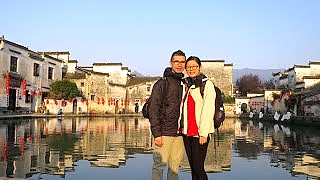Introduction:
Hoisin sauce is a thick, flavorful condiment commonly used in Chinese cuisine as a dipping sauce, marinade, or glaze for meat dishes. While store-bought hoisin sauce is readily available, making it at home allows you to control the ingredients and customize the flavor to your taste preferences. This DIY hoisin sauce recipe is simple to prepare and uses easily sourced ingredients.
Ingredients:
- 1/4 cup soy sauce
- 2 tablespoons peanut butter (smooth)
- 1 tablespoon honey or molasses
- 1 tablespoon rice vinegar or apple cider vinegar
- 1 clove garlic, minced
- 1 teaspoon sesame oil
- 1/2 teaspoon Chinese five-spice powder
- 1/4 teaspoon black pepper
- 1/4 teaspoon salt
- 1/4 teaspoon chili oil or paste, or sriracha or other chili sauce (optional, for heat)
Method:
- Combine Ingredients: In a small bowl, whisk together the soy sauce, peanut butter, honey or molasses, rice vinegar, minced garlic, sesame oil, Chinese five-spice powder, black pepper, and chili paste (if using). Mix until smooth and well combined.
- Adjust Consistency: If the hoisin sauce is too thick, you can thin it out with a little water or additional soy sauce. If it's too thin, you can add more peanut butter or honey to thicken it to your desired consistency.
- Taste and Adjust: Taste the hoisin sauce and adjust the seasoning as needed. You can add more soy sauce for saltiness, honey for sweetness, vinegar for acidity, or chili paste for heat, according to your taste preferences.
- Store: Transfer the homemade hoisin sauce to a clean, airtight container and store it in the refrigerator for up to 2 weeks. Allow the flavors to meld together for at least an hour before using the sauce.
Usage Tips:
- Use homemade hoisin sauce as a dipping sauce for spring rolls, dumplings, or roasted meats.
- Brush it on grilled chicken, pork, or tofu as a flavorful marinade or glaze.
- Stir it into stir-fries or noodle dishes for added depth of flavor.
- Adjust the sweetness, saltiness, and spiciness of the hoisin sauce to suit your taste preferences.
Enjoy your homemade hoisin sauce in your favorite Chinese dishes!
Hoisin sauce is commonly used as a condiment for Peking Duck. Peking Duck is a famous dish from Beijing (formerly known as Peking), where roasted duck is served with thin pancakes, along with condiments such as hoisin sauce, sliced scallions, and cucumber.
When enjoying Peking Duck, diners typically spread hoisin sauce onto a pancake, then add slices of roasted duck, along with some sliced scallions and cucumber. The pancake is then rolled up and eaten as a delicious and flavorful wrap.
Hoisin sauce complements the rich, savory flavor of the roasted duck with its sweet, salty, and umami notes. It adds depth and complexity to each bite and enhances the overall dining experience.
While hoisin sauce is a key component of Peking Duck, you can also use it as a condiment for other dishes, such as stir-fries, grilled meats, spring rolls, and more. Its versatility makes it a popular choice in Chinese cuisine.
Chinese cuisine is an intricate tapestry of flavors, techniques, and regional specialties that has evolved over thousands of years. From the fiery spices of Sichuan to the delicate dim sum of Cantonese cuisine, every region of China offers its own culinary delights. For visitors to China, exploring the diverse and dynamic world of Chinese food is an essential part of experiencing the country's rich cultural heritage. Here's a more extensive exploration of Chinese cuisine for visitors:
Regional Diversity:
Sichuan Cuisine: Hailing from the southwestern province of Sichuan, this cuisine is famed for its bold, spicy, and numbing flavors. Sichuan peppercorns, chili peppers, and aromatic spices are used liberally in dishes like Mapo Tofu, Dan Dan Noodles, and Sichuan Hot Pot, creating a symphony of flavors that tingles the taste buds.
Cantonese Cuisine: With its emphasis on fresh ingredients and delicate flavors, Cantonese cuisine is highly regarded for its seafood dishes, roasted meats, and dim sum. Steamed fish, Char Siu (barbecue pork), and Har Gow (shrimp dumplings) are just a few examples of the exquisite dishes that showcase Cantonese culinary mastery.
Shanghai Cuisine: Reflecting its coastal location and cosmopolitan history, Shanghai cuisine combines influences from Jiangsu, Zhejiang, and Anhui provinces. Sweet and Sour Mandarin Fish, Shanghai Soup Dumplings (Xiaolongbao), and Drunken Chicken are some of the signature dishes that highlight the diverse flavors and textures of this culinary tradition.
Beijing Cuisine: As the capital of China, Beijing boasts a rich culinary heritage deeply rooted in imperial traditions. Peking Duck, a dish with crispy skin and succulent meat served with pancakes and hoisin sauce, is a quintessential Beijing delicacy. Other notable dishes include Zhajiangmian (Beijing Noodles), Mongolian Hot Pot, and Beijing-style meat pies.
Hunan Cuisine: Known for its bold and aromatic flavors, Hunan cuisine features dishes that are spicy, sour, and intensely flavorful. Chairman Mao's Red-Braised Pork, Dong'an Chicken, and Steamed Fish Head with Chopped Chili exemplify the fiery and robust nature of Hunanese cooking, which makes ample use of chili peppers, garlic, and fermented ingredients.
Street Food and Snacks:
Jianbing: This savory Chinese crepe is a popular breakfast option, consisting of a thin pancake filled with eggs, scallions, cilantro, and various fillings such as crispy fried dough, pickled vegetables, or chili sauce.
Baozi: These steamed buns are filled with a variety of savory or sweet fillings, including pork, vegetables, or red bean paste. Baozi are a popular street food snack and can be found in teahouses, markets, and street stalls across China.
Roujiamo: Often referred to as Chinese Hamburgers, roujiamo features savory braised meat stuffed inside a flatbread, offering a hearty and flavorful snack that's perfect for on-the-go eating.
Dining Etiquette and Customs:
Family-Style Dining: Chinese meals are typically served family-style, with multiple dishes shared among diners seated around a table. It's customary to use chopsticks to pick up food from communal dishes and to serve elders before oneself.
Toasting and Ganbei: When dining with Chinese hosts, expect toasts (ganbei) with alcohol, usually baijiu (Chinese liquor). It's polite to reciprocate the toast and drink in moderation, but declining politely is acceptable if you don't drink alcohol.
Tea Culture: Tea is an integral part of Chinese dining culture, with a wide variety of teas available to complement different dishes. Green tea, oolong tea, and pu'er tea are among the most popular choices, and serving tea to guests is a sign of hospitality and respect.
Street Markets and Night Markets:
Wangfujing Snack Street, Beijing: Located near the Forbidden City, this bustling street market offers a wide variety of traditional snacks, street food, and local delicacies. Visitors can sample everything from scorpions on a stick to traditional Beijing snacks like Jianbing and Tanghulu (candied fruit skewers).
Shanghai Old Street, Shanghai: Nestled in the heart of the city's historic district, Shanghai Old Street is a bustling marketplace where visitors can explore narrow alleyways lined with traditional shops, street vendors, and food stalls. From steamed dumplings and stinky tofu to hand-pulled noodles and sugar-coated haws, there's something to satisfy every craving.
Dietary Considerations:
Vegetarian and Vegan Options: While Chinese cuisine traditionally features a wide range of meats and animal products, vegetarian and vegan options are becoming increasingly available, especially in larger cities and tourist destinations. Buddhist restaurants (????, s�sh� c?nt?ng) often offer meat-free versions of classic dishes, and plant-based ingredients like tofu, mushrooms, and seasonal vegetables are widely used in Chinese cooking.
Exploring the diverse and delicious world of Chinese cuisine is an essential part of any visit to China. From regional specialties and street food snacks to dining etiquette and cultural customs, the culinary landscape of China offers a rich tapestry of flavors, traditions, and experiences that are sure to delight and inspire visitors from around the world. Bon app�tit!.
 A taste of China at home : HoiSin sauce
A taste of China at home : HoiSin sauce















